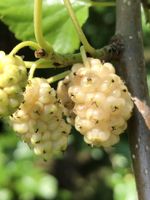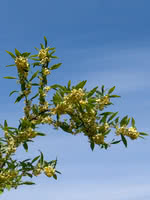Mon-Fri 9am - 5pm Mountain time
Russian White Mulberry vs Cherry Prinsepia
Morus alba tatarica
Prinsepia sinensis
NOT AVAILABLE THIS SEASON - MIGHT RETURN
CUSTOM GROW
Russian White Mulberry is a cold hardy and adaptable tree. It is a great choice for the impatient gardener as it reaches its mature height in a short period of time and has an attractive, dense, and rounded form.
Odd looking berries are produced among a backdrop of glossy, deep green foliage. The blackberry-esque berries ripen slowly over the season, ranging in color from white, pink, and purple-violet. While the berries are not well regarded for fresh eating, they have made tasty jams and preserves.
Cherry Prinsepia is an attractive, cold hardy shrub with thorny stems and a rounded shape.
Primarily used for its shrub and hedge characteristics, Cherry Prinsepia is also grown for its ornamental fruit. Tart in flavor, the red berries are edible and enjoyed by birds and humans alike.
If deer are an issue on your property, try planting Cherry Prinsepia in a tight row to create a dense hedge to deter them.
Note: Unfortunately this difficult to grow species is not currently scheduled to grow at TreeTime.ca. Perhaps try purchasing seed from SeedTime.ca and growing your own? Or sign up for a restock notification above.

